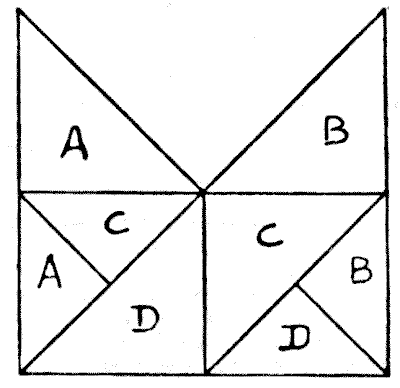(related to Problem: Dissecting a Mittre)
The diagram below shows how to cut into five pieces to form a square. The dotted lines are intended to show how to find the points $C$ and $F$ — the only difficulty. $A B$ is half $B D,$ and $A E$ is parallel to $B H.$ With the point of the compasses at $B$ describe the arc $H E,$ and $A E$ will be the distance of $C$ from $B.$ Then $F G$ equals $B C$ less $A B.$

This puzzle — with the added condition that it shall be cut into four parts of the same size and shape — I have not been able to trace to an earlier date than 1835. Strictly speaking, it is, in that form, impossible of solution; but I give the answer that is always presented, and that seems to satisfy most people.
We are asked to assume that the two portions containing the same letter — $AA,$ $BB,$ $CC,$ $DD$ — are joined by "a mere hair," and are, therefore, only one piece. To the geometrician this is absurd, and the four shares are not equal in area unless they consist of two pieces each. If you make them equal in area, they will not be exactly alike in shape.

This eBook is for the use of anyone anywhere in the United States and most other parts of the world at no cost and with almost no restrictions whatsoever. You may copy it, give it away or re-use it under the terms of the Project Gutenberg License included with this edition or online at http://www.gutenberg.org. If you are not located in the United States, you'll have to check the laws of the country where you are located before using this ebook.